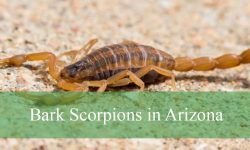There’s something magical about watching a hummingbird hover in mid-air, wings a blur, as it sips nectar from a flower or feeder. In Tennessee, these tiny marvels bring color and energy to gardens, woodlands, and backyards throughout the warmer months—and even sometimes in winter.
While the Ruby-throated Hummingbird is a familiar summer favorite, Tennessee has quietly become a surprising hotspot for rare hummingbird sightings. From bold Rufous Hummingbirds in winter to dazzling visitors like the Broad-billed or Calliope, each one tells a fascinating migration story.
In this guide, you’ll discover 10 hummingbird species that have been spotted across the state. With pictures and clear identification tips, it’s perfect for bird lovers, backyard watchers, and anyone who finds joy in the shimmering beauty of hummingbirds.
Types of Hummingbirds Found in Tennessee
Ruby-throated Hummingbird (Archilochus colubris)
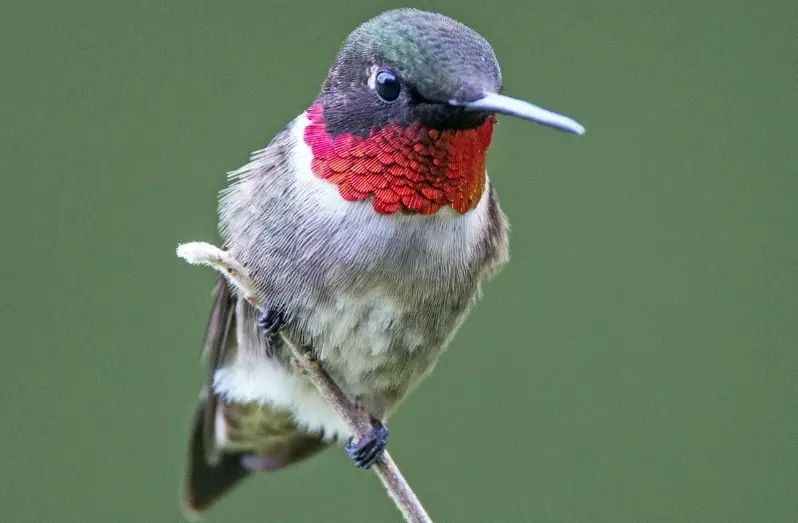
The Ruby-throated Hummingbird is the most common and widespread hummingbird in Tennessee. This species is the only one that breeds regularly in the state and is a familiar visitor to backyard nectar feeders during spring and summer. They typically arrive in early April and begin their southward migration by late September.
Adult males are easily identified by their brilliant, iridescent red throat (called a gorget), emerald green back, and white underparts. Females lack the red throat and instead have a pale, speckled throat with greenish backs and flanks. Both sexes are about 3–3.5 inches long and weigh roughly 2.5–3.5 grams.
These birds are extremely agile in flight and can hover, fly backward, and dart quickly between flowers. They primarily feed on flower nectar and small insects, often returning to the same nectar source multiple times per day. Ruby-throated Hummingbirds are territorial and males will defend feeders or flowering patches aggressively.
In Tennessee, they are most commonly seen in woodlands, gardens, and along forest edges. Rural and suburban areas with plenty of blooming flowers or hummingbird feeders attract large numbers during peak migration in late summer.
Rufous Hummingbird (Selasphorus rufus)
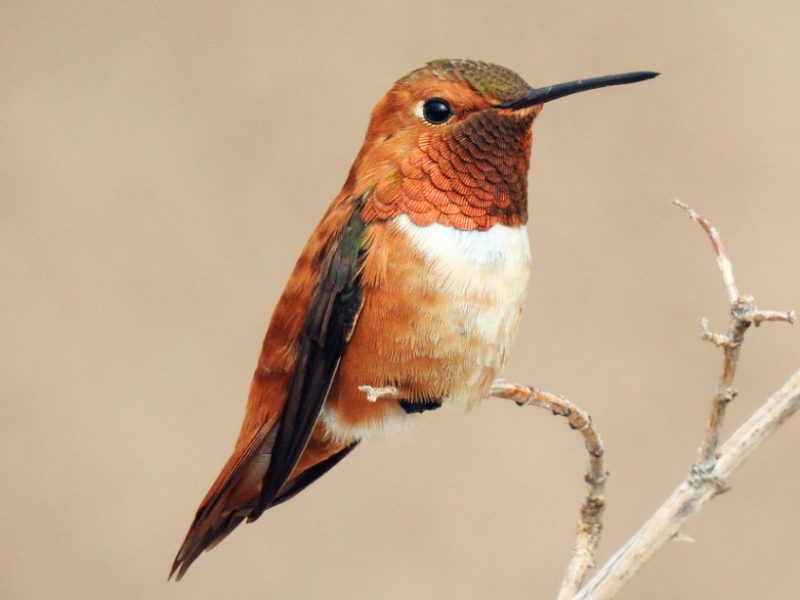
The Rufous Hummingbird is a migratory species known for its long-distance travel and bold behavior. While not native to Tennessee, it is frequently spotted during fall and winter months, especially from late October through February. This makes it one of the most commonly reported “winter hummingbirds” in the state.
Males are strikingly colored with a coppery-orange back and flanks, white chest, and an iridescent orange-red throat. Females are less vivid, with greenish backs, rusty flanks, and a speckled throat. They are slightly larger than the Ruby-throated Hummingbird, averaging 3.5–4 inches in length.
These hummingbirds are known for their aggressive nature, often chasing off larger birds from feeders. Despite their small size, they are fearless and highly territorial, especially during feeding. Their rapid wingbeats and buzzy calls help distinguish them from other species.
In Tennessee, Rufous Hummingbirds are most often seen in western and central parts of the state during winter, especially in gardens with heated feeders or blooming winter plants. They are of special interest to birders who keep feeders up year-round.
Black-chinned Hummingbird (Archilochus alexandri)
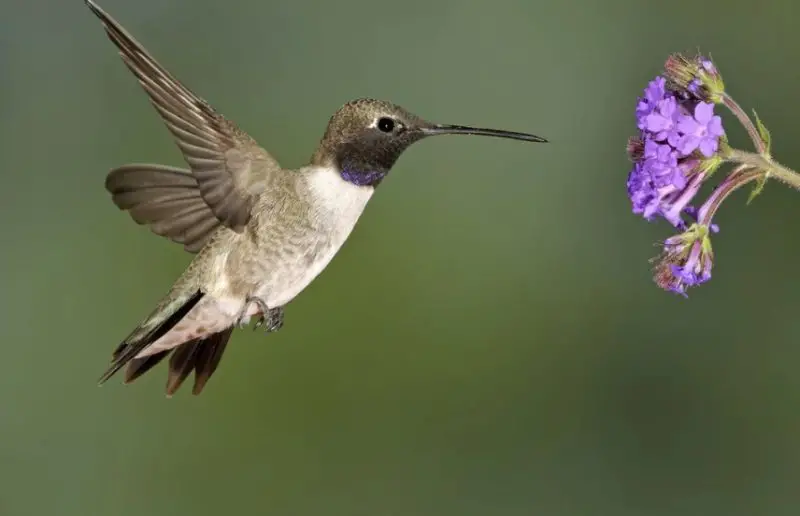
The Black-chinned Hummingbird is a rare but increasingly observed visitor in Tennessee, usually during migration seasons or in winter. This western species has expanded its range eastward, with sporadic sightings across central and southern Tennessee.
Males are identified by their black chin and throat with a narrow band of iridescent purple at the base, visible under direct light. Females resemble Ruby-throated females but have duller coloring and less distinctive markings. The average size is about 3.25 inches in length.
Black-chinned Hummingbirds prefer open woodlands, deserts, and suburban environments in their typical range, but in Tennessee, they are usually seen at feeders during migration. Their call is a soft “tik” and their wings hum at a lower pitch than Ruby-throats.
Though uncommon, this species has been recorded more frequently in Tennessee in recent years, especially in the fall. Homeowners with feeders in quiet areas may get lucky sightings between September and December.
Calliope Hummingbird (Selasphorus calliope)
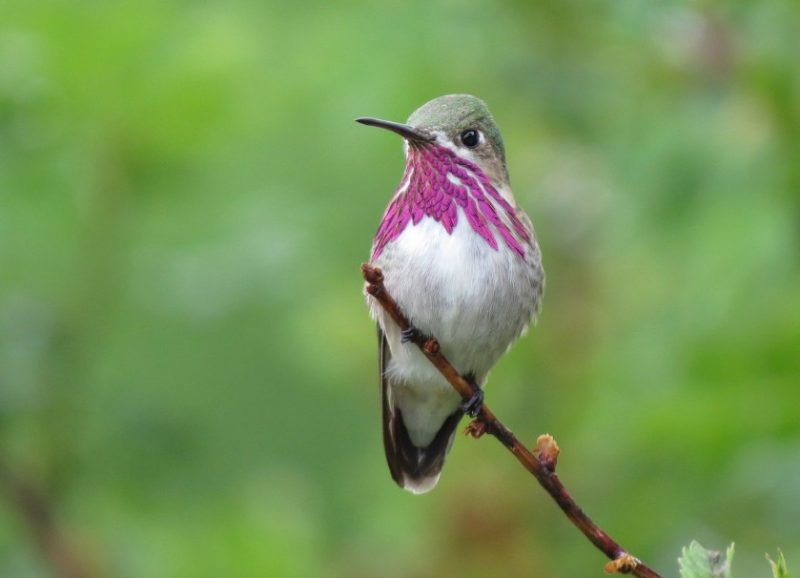
The Calliope Hummingbird is the smallest bird species in North America and an extremely rare visitor to Tennessee. Though native to the western United States, a few individuals have been documented in Tennessee during fall and winter, particularly in the eastern portion of the state.
Adult males are distinctive with their white chest and unique streaked magenta throat feathers that flare out like rays. Females and juveniles have a peach-colored wash on their sides and a subtle, speckled throat. They measure just 2.75–3.25 inches long and weigh about 2.5 grams.
Despite their size, Calliope Hummingbirds are surprisingly hardy and have been recorded surviving harsh winter conditions. They feed actively at feeders and flowering plants and are less aggressive than Rufous or Black-chinned hummingbirds.
In Tennessee, this species is a rare treat for hummingbird enthusiasts, typically spotted during winter months by alert birders who leave nectar feeders up year-round. Sightings are most often verified by photographs and shared among local birdwatching groups.
Allen’s Hummingbird (Selasphorus sasin)
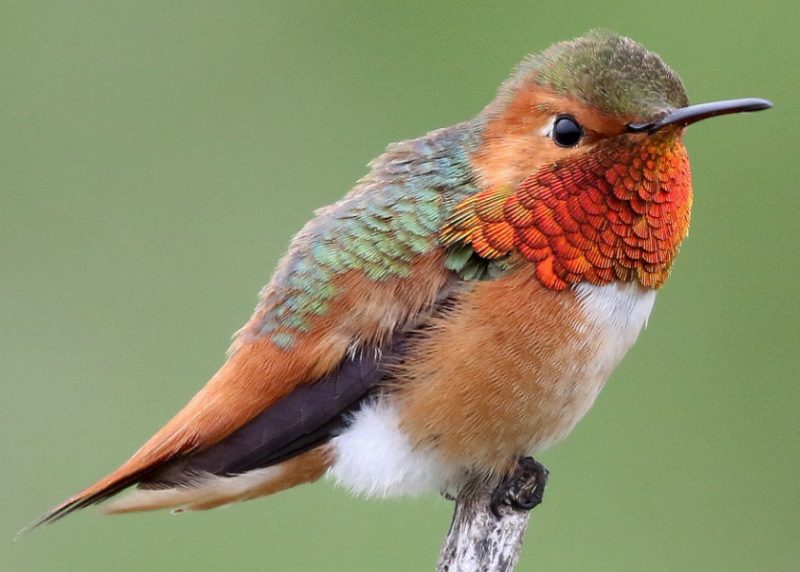
Allen’s Hummingbird is another very rare hummingbird species in Tennessee, usually seen as an out-of-range winter visitor. It is often confused with the Rufous Hummingbird due to their similar coloring and behavior, but subtle differences can help separate them with close observation or banding.
Adult males feature an iridescent orange-red throat, bright orange flanks, and a green back. Females and immatures are more subdued, with green backs and light orange or buffy underparts. They are around 3.5 inches in length, closely matching the size of Rufous Hummingbirds.
Allen’s Hummingbirds are known for their fast, darting flight and aggressive behavior at feeders. They favor coastal brushy habitats in their native California breeding range but sometimes wander eastward during migration.
In Tennessee, sightings are few and far between, typically occurring during winter and confirmed by experts. Gardeners and birdwatchers maintaining warm-weather plants or winter nectar feeders may occasionally encounter this elusive visitor.
Anna’s Hummingbird (Calypte anna)
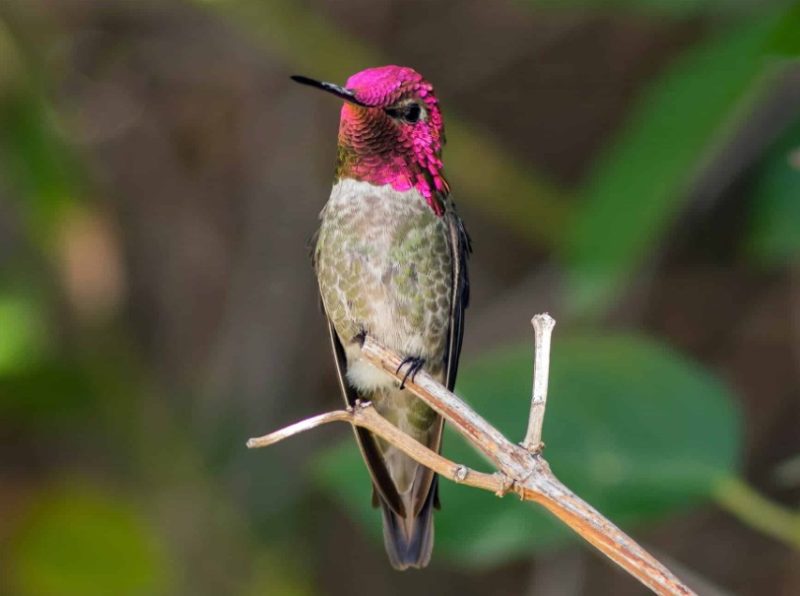
Anna’s Hummingbird is native to the West Coast but occasionally wanders eastward, with a few rare individuals recorded in Tennessee during the winter months. This species is one of the few hummingbirds that can overwinter in relatively cold climates, thanks to its ability to enter torpor and conserve energy.
Adult males are striking, with a vivid rose-pink crown and gorget that can appear almost iridescent red or magenta in sunlight. Females are less colorful but have a faint reddish wash on the throat and a gray-green back. They are slightly larger than Ruby-throated Hummingbirds, measuring around 3.9 to 4.3 inches in length.
Unlike most hummingbirds, Anna’s Hummingbirds are known to sing—producing a series of scratchy notes and squeaky whistles. They also perform dramatic courtship dives, during which males ascend and plummet rapidly while producing a loud burst of sound with their tail feathers.
In Tennessee, Anna’s Hummingbirds are extremely rare but are occasionally reported near heated feeders or in sheltered areas with winter-blooming flowers. Most sightings have occurred in western Tennessee, often from November to February.
Broad-tailed Hummingbird (Selasphorus platycercus)
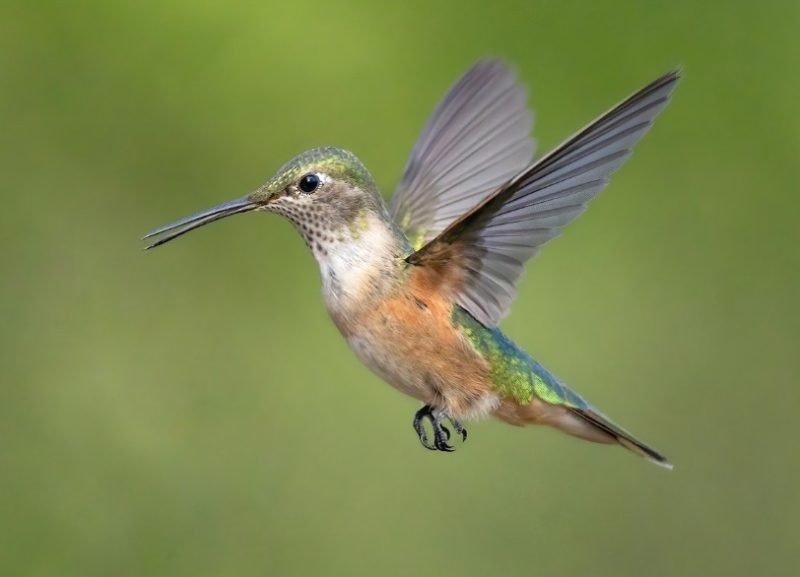
The Broad-tailed Hummingbird is primarily a bird of the mountainous western U.S., but it has been recorded in Tennessee on rare occasions during fall migration. These birds are often confused with Rufous or Allen’s hummingbirds due to similar coloration, but careful observation can reveal their unique features.
Males are distinguished by their glittering rosy-pink throats, metallic green backs, and pale underparts. Females are green above with a whitish chest and light speckling on the throat. Adults measure about 3.75 to 4 inches in length and have slightly longer wings than most hummingbirds.
One of the most recognizable traits of this species is the distinct trilling sound produced by the male’s wings in flight, especially during courtship displays. Broad-tailed Hummingbirds are generally calm and less territorial than Rufous Hummingbirds.
Although they are not regular visitors to Tennessee, they have been reported during fall and winter by dedicated hummingbird banders and homeowners with year-round feeders. Eastern Tennessee seems to be the most likely location for rare sightings.
Buff-bellied Hummingbird (Amazilia yucatanensis)

The Buff-bellied Hummingbird is a rare and exotic species primarily found in South Texas and parts of Mexico, but occasional wanderers have turned up in the southeastern U.S., including a few verified sightings in Tennessee.
This species is medium-sized for a hummingbird, about 4–4.3 inches long. It features a vivid emerald green head and back, cinnamon or buff-colored belly, and a long, slightly decurved bill that is red with a black tip. These colorful traits make them stand out when compared to more common hummingbirds.
Buff-bellied Hummingbirds are relatively bold and can dominate nectar feeders when present. They favor habitats like subtropical thickets, wooded edges, and suburban gardens with plenty of flowering plants. Their wingbeats are slower and deeper, making a distinctive humming sound.
In Tennessee, sightings are exceptionally rare but have occurred during fall or early winter in the western and central parts of the state. Birdwatchers who maintain native plants and nectar feeders may attract this species during its post-breeding dispersal.
Green Violetear (Mexican Violetear) (Colibri thalassinus)
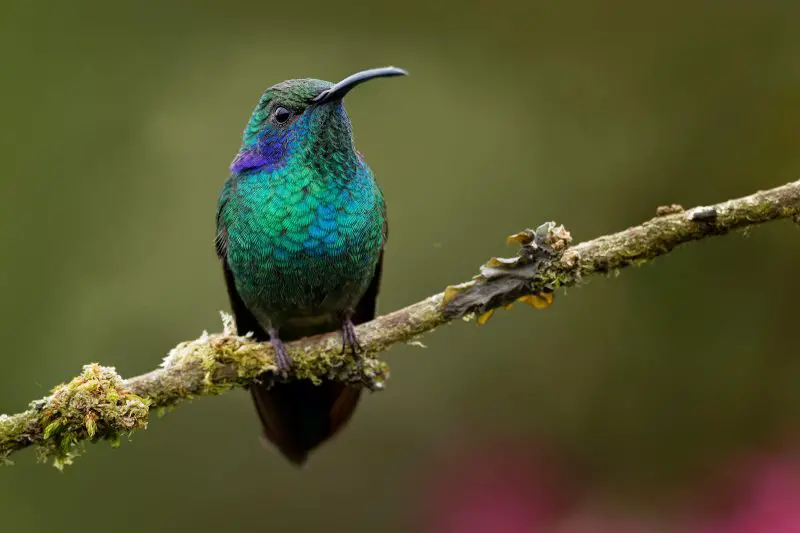
The Green Violetear, also known as the Mexican Violetear, is a Central American species that occasionally wanders far north, with a handful of sightings in the southeastern United States, including Tennessee. These vagrant birds are among the rarest hummingbirds recorded in the state.
They are larger than typical hummingbirds, reaching about 4.7–5 inches in length. Their most stunning feature is their metallic green body with a shimmering violet-blue patch extending from the cheek to the neck. Their tail is dark with broad iridescent bands.
Green Violetears are solitary and tend to forage quietly in forest edges and shaded areas. They do not often engage in aggressive defense of feeders but are notable for their distinctive chirping call, which they repeat while hovering near flowers.
In Tennessee, only a few individuals have ever been recorded, usually during late summer or early fall. These rare appearances are typically in wooded or mountainous regions and are met with excitement by local birding communities.
Broad-billed Hummingbird (Cynanthus latirostris)
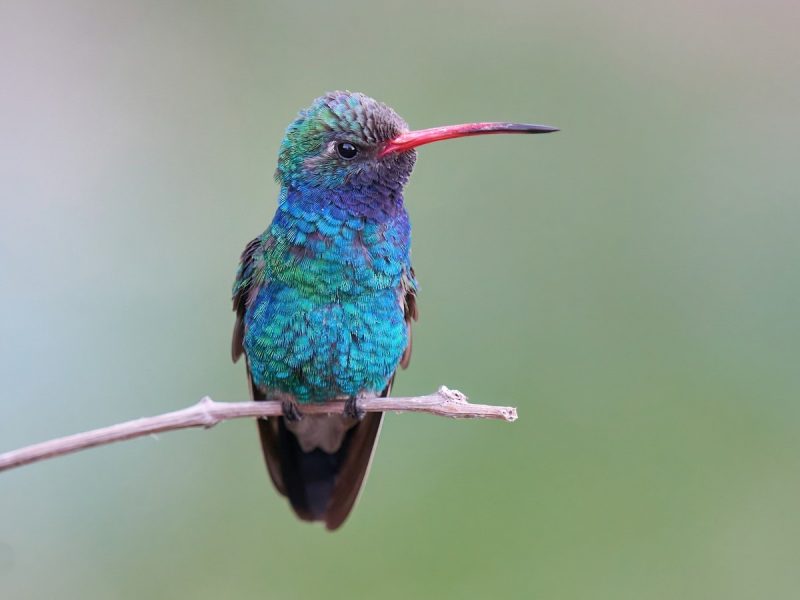
The Broad-billed Hummingbird is another southwestern species that occasionally shows up far outside its normal range. It is considered a vagrant in Tennessee, with only a small number of confirmed records, usually during fall and early winter.
This species is known for its vivid coloration. Males have a glittering blue throat and chest, green upperparts, and a bright red bill with a black tip. Females are duller but still display a slightly curved red bill and greenish-gray underparts. Adults measure about 3.5–4 inches long.
Broad-billed Hummingbirds are typically found in canyons, desert scrub, and riparian woodlands in the Southwest. They are bold and often approach feeders readily. Their calls are sharp and metallic, and they can hover and feed with great precision.
Though very rare in Tennessee, this species has been reported during winter, mostly at feeders maintained through the colder months. Confirmed sightings often require photographic documentation or expert identification due to similarity with other green-backed hummingbirds.
FAQs About Hummingbirds in Tennessee
When do hummingbirds arrive in Tennessee?
Most hummingbirds, especially the Ruby-throated Hummingbird, arrive in Tennessee during early to mid-April. Males usually appear a few days before females to establish feeding territories. Migration peaks in late spring and continues into early summer.
When do hummingbirds leave Tennessee?
Hummingbirds begin migrating south in late August, with most gone by mid-October. However, some rare species such as Rufous and Allen’s Hummingbirds may overwinter and be spotted into December or even February.
What is the most common hummingbird in Tennessee?
The Ruby-throated Hummingbird is by far the most common and widespread hummingbird species in Tennessee. It is the only one that breeds regularly in the state and is a familiar summer visitor to gardens and feeders.
Are there any hummingbirds in Tennessee during the winter?
Yes, a few species such as the Rufous Hummingbird and Anna’s Hummingbird can overwinter in Tennessee. These winter hummingbirds are rare but increasingly observed, especially in areas where nectar feeders are left out during the colder months.
How can I attract hummingbirds to my yard in Tennessee?
You can attract hummingbirds by planting native nectar-producing flowers such as bee balm, trumpet vine, and cardinal flower. Hanging red-colored feeders filled with a sugar-water solution (1 part sugar to 4 parts water, no dye) is also highly effective.
Should I leave my hummingbird feeder out in winter?
Yes, leaving feeders out in winter can help support rare overwintering hummingbirds like the Rufous Hummingbird. Be sure to keep the nectar from freezing by bringing the feeder indoors at night or using a heated feeder in colder areas.
How many hummingbird species have been seen in Tennessee?
At least 10 species of hummingbirds have been recorded in Tennessee, including common breeders like the Ruby-throated Hummingbird and rare winter visitors such as the Broad-tailed and Calliope Hummingbirds.
Do hummingbirds nest in Tennessee?
Yes, the Ruby-throated Hummingbird nests in Tennessee. Females build small, cup-shaped nests using spider silk, moss, and plant fibers. Nests are typically built on tree limbs in wooded or semi-wooded areas.
Are hummingbirds territorial?
Yes, most species of hummingbirds are highly territorial, especially males. They often defend feeders and flowering areas aggressively from other hummingbirds or even larger birds and insects.
Can I report rare hummingbird sightings in Tennessee?
Absolutely. If you spot a rare or unusual hummingbird species, you can report your sighting to local birdwatching organizations, Tennessee Ornithological Society chapters, or contribute your data to eBird.org for scientific tracking.


